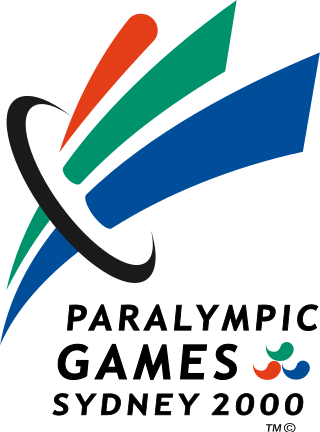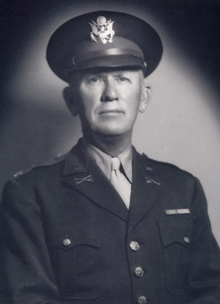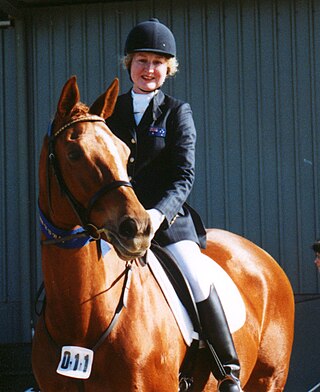Related Research Articles

The 2000 Summer Paralympic Games or the XI Summer Paralympics were held in Sydney, New South Wales, Australia, between 18 and 29 October. The Sydney Paralympics was last time that the Summer Paralympics were organized by two different Organizing Committees. In this edition, a record 3,801 athletes from 120 National Paralympic Committees participated in 551 events in 18 sports, and until the 2006 Commonwealth Games held in Melbourne, it was the second largest sporting event ever until that date held in Australia and the Southern Hemisphere. Sydney was the eighth city to host the Olympics and the Paralympics on same venues at the same year, and the first since Barcelona 1992 that they were organized in complete conjunction with the Olympics. They were also the first Paralympic Games outside the Northern Hemisphere and also in Oceania.

A horse show is a judged exhibition of horses and ponies. Many different horse breeds and equestrian disciplines hold competitions worldwide, from local to the international levels. Most horse shows run from one to three days, sometimes longer for major, all-breed events or national and international championships in a given discipline or breed. Most shows consist of a series of different performances, called classes, wherein a group of horses with similar training or characteristics compete against one another for awards and, often, prize money.
The equestrian events at the 1972 Summer Olympics in Munich included show jumping, dressage and eventing. All three disciplines had both individual and team competitions. The equestrian competitions were held at 3 sites: an existing equestrian facility at Riem for the individual show jumping and eventing competitions, the Olympic Stadium in Munich for the Nations Cup, and Nymphenburg, a Baroque palace garden, for the sold-out dressage. 179 entries, including 31 women, competed from 27 countries: Argentina, Australia, Austria, Belgium, Bolivia, Bulgaria, Brazil, Canada, Chile, Denmark, German Democratic Republic (GDR), France, Federal Republic of Germany (FRG), Great Britain, Hungary, Ireland, Italy, Japan, Mexico, the Netherlands, Poland, Portugal, Soviet Union, Spain, Sweden, Switzerland, and the USA. The youngest participant was Kurt Maeder from Switzerland at 19 years old, while the oldest rider was Lorna Johnstone from Great Britain at 70 years old.

Equestrian sports were first included in the Olympic Games in the Summer Olympics of 1900 in Paris. They were again included in 1912, and have been included in every subsequent edition of the Games. The Olympic equestrian disciplines are dressage, eventing, and show-jumping. In each discipline, both individual and team medals are awarded. Women and men compete on equal terms.
Equestrian competitions in all three disciplines at the Beijing 2008 Summer Olympics were held from 9 August to 21 August at the Hong Kong Sports Institute and Sheung Yue River in Hong Kong. It was the second time that the equestrian events were hosted by a member of the IOC other than the member hosting the main games. Unlike 1956, however, the equestrian events were part of the main games, and were held within the same period.

Hiram Edwin Tuttle was an American equestrian who competed in dressage at the 1932 Summer Olympics and in the 1936 Summer Olympics. He is the only American dressage rider to win an individual medal at an Olympic Games. Tuttle was a lawyer in Boston prior to being a US Army quartermaster officer from 1930 to 1944. He owned and trained his own horses, unusual in a time when the majority of Olympic competitors rode Army-owned horses, and is buried near three of them at the cemetery in Fort Riley.
Nicole Uphoff is a German equestrian who competes in the sport of dressage. She won four gold medals in individual and team competition at the 1988 and 1992 Summer Olympics. Riding her star horse, Rembrandt, Uphoff also won numerous other international competitions, including the World Equestrian Games and the European Dressage Championships.

Anne Patricia Dunham OBE is a British Para-equestrian who has competed in the Paralympic Games.
The individual eventing event, part of the equestrian program at the 2000 Summer Olympics, was held from 20 to 22 September 2000 in the Sydney International Equestrian Centre. Like all other equestrian events, the eventing competition was mixed gender, with both male and female athletes competing in the same division.

Rosalie Fahey is a Paralympic equestrian competitor from Australia. She won a bronze medal at the 2000 Sydney Games in the Mixed Dressage – Championship grade I event.
The team eventing event, part of the equestrian program at the 2000 Summer Olympics was held from 16 to 19 September 2000. The competition was held in the Sydney International Equestrian Centre. In 2000, as in 1996, the team event was a separate event from the individual competition which was held from the 20–22 September. A rider could compete in both competitions. This would be the final time to date, that this format of two separate events has been used. Like all other equestrian events, the eventing competition was mixed gender, with both male and female athletes competing in the same division. Twelve teams, each consisting of between three and four horse and rider pairs, entered the contest.
The individual dressage event, part of the equestrian program at the 2000 Summer Olympics, was held from 26 to 30 September 2000 at the Sydney International Equestrian Centre 45 miles outside of Sydney, Australia. Like all other equestrian events, the dressage competition was mixed gender, with both male and female athletes competing in the same division. Forty-eight horse and rider pairs were entered.
The team dressage event, part of the equestrian program at the 2000 Summer Olympics was held on 26 September 2000 at the Sydney International Equestrian Centre 45 miles outside of Sydney, Australia. The results of the first round of the individual dressage were used to award rankings. Like all other equestrian events, the dressage competition was mixed gender, with both male and female athletes competing in the same division. Nine teams, each consisting of four horse and rider pairs, entered the contest.

Kristy Oatley-Nist is an Australian equestrian. She represented Australia at the 2000, 2008, 2012 and 2016 Summer Olympics in the equestrian discipline of dressage.

Lyndal Oatley is an Australian equestrian. She represented Australia at two Summer Olympics in equestrian dressage.
Para-equestrian classification is a system for para-equestrian sport is a graded system based on the degree of physical or visual disability and handled at the international level by the FEI. The sport has eligible classifications for people with physical and vision disabilities. Groups of eligible riders include The sport is open to competitors with impaired muscle power, athetosis, impaired passive range of movement, hypertonia, limb deficiency, ataxia, leg length difference, short stature, and vision impairment. They are grouped into five different classes to allow fair competition. These classes are Grade I, Grade II, Grade III, Grade IV, and Grade V(Grade Names Changed as of Jan 2017). The para-equestrian classification does not consider the gender of the rider, as equestrines compete in mixed gender competitions.
Para-equestrian is an equestrian sport governed by the International Federation for Equestrian Sports (FEI), and includes two competitive events: One is para-equestrian dressage, which is conducted under the same basic rules as conventional dressage, but with riders divided into different competition grades based on their functional abilities. The other is para-equestrian driving, which operates under the same basic rules as combined driving but places competitors in various grades based on their functional abilities.

Equestrian at the 2016 Summer Paralympics consists of 11 dressage events, ten for individual riders across five classes, and a single mixed team, mixed category event. The competitions were held in the Olympic Equestrian Centre in Rio, in September 2016.
Kelly Layne is an Australian Dressage rider and trainer. She planned on qualifying to represent her country at the 2016 Summer Olympics in Rio de Janeiro. However, Layne was unable to compete in the final qualifying event due to an injury suffered by her horse, Udon P, forcing her to withdraw. While born in Australia, Layne is currently based in Wellington, Florida. Layne also helped found her own riding team, "Dream Team Dressage".
The CHIO Rotterdam is an annual international horse show held in Rotterdam, Netherlands. The show is held every year in June and the biggest international equestrian outdoor event in The Netherlands, hosted at the 'Rotterdamse Manege' in Kralingen.
References
- 2000 Summer Olympics official report. Volume 1. p. 388.
- ↑ "HISTORY OF EVENT". Equestrian Australia. The Sydney CDI. Retrieved 9 November 2023.
